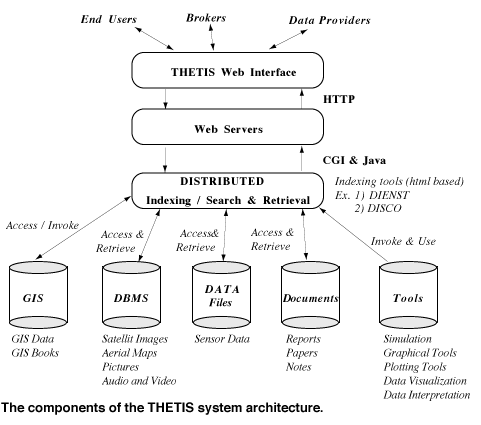A Data Management and Visualization System for Coastal Zone Management of the Mediterranean
by Catherine Houstis
The Mediterranean coastal regions have been, and continue to be, under threat from over-exploitation, resulting in environmental degradation, most notably visible as marine pollution. THETIS is a 30 months research project starting in June 1998, that will establish a data management and data visualisation system for supporting Coastal Zone Management (CZM) for the Mediterranean Sea.
CZM is a methodology for the holistic management of all coastal resources with the ultimate aim of promoting sustainable development of the coastal zones. CZM recognises that pollution problems transcend political boundaries and so to be effective CZM requires the integration of multinational data collection, data management and data visualisation across many scientific disciplines such as marine biology, oceanography, chemistry and engineering.
The THETIS project seeks to address the frequent requirement of scientists, engineers and decision-makers to access, process and subsequently visualise data collected and stored in different formats and held at different locations. The need exists for tools that enable the integration of these data, together with their associated data models, interpretation models, and visualisation environments. The objective of the THETIS project is to build an advanced integrated interoperable system for transparent access and visualisation of data repositories, via the Internet and the Web. The system will be a working prototype, which will demonstrate its ability to respond to users such as scientists and local authorities that use scientific information for decision making.
The technologies used at this project are Web tools, digital library indexing/search service, over the Web visualisation, 2D and 3D visualisation tools, Geographical Information Systems, Virtual Reality Modelling Language).
The expected benefits of the THETIS system for the users of the CZM application, the citizens and the European industries are very important. Integrated and easy access to information creates new services, thus new job markets. Integrated data repositories access and interactive use for CZM creates better coastal zone preservation with immediate impact to the European citizen.
Moreover, companies will be able to use the system to sell their information and create new integrated services for their customers. Consulting firms can make use of the THETIS system and tools to support their business. Finally environmental policies concerning the use of coastal resources can be monitored via the integrated information support and easy access of THETIS.

Figure: The components of the THETIS system architecture.
As shown in the figure, clients submit simple or complex queries via the Web interface (Web browser) to the system. User requests invoke various services such as metadata, index and search to locate the objects, which match the user-query. We assume that documents are stored in DIENST servers, and metadata services are provided to access them. The documents could be research papers written by scientists studying the coastal properties of the Mediterranean Sea. Images could be indexed via relational or object oriented databases in various formats. It is possible that the information about a region could be dispersed across several databases. This means that the information system has to index and search across the various databases to obtain the corresponding information. It is possible that information could be replicated across the databases. For this service, distributed search queries (via the Web) are sent to the various databases to obtain the objects. Metadata services describing the GIS objects are used to index/search for the appropriate GIS objects (multi-dimensional data and images). Distributed search agents collect/transform the various information objects and present the user with a composite result object.
The participants of the project are ICS-FORTH, ERCIM, INRIA, CNR, the Institute of Marine Biology of Crete (Greece), AEROSPATIALE (France), the IACM-FORTH (Greece), the University of Crete, HR Wallingford (United Kingdom), and RECORMED Network (France).
Please contact:
Catherine Houstis - ICS-FORTH
Tel: +30 81 391729
E-mail: houstis@ics.forth.gr
